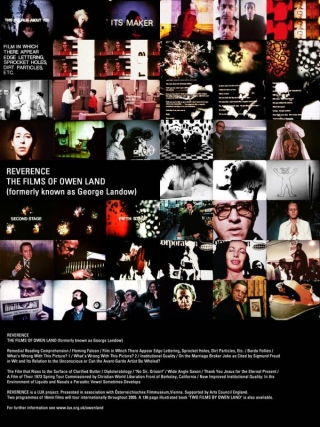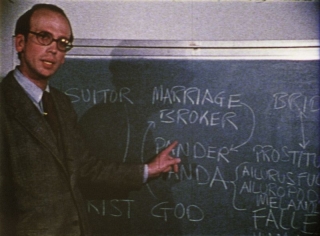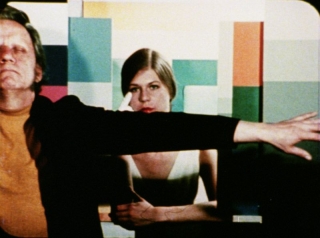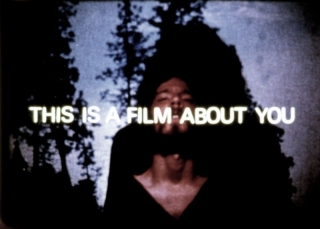Date: 25 January 2005 | Season: Owen Land | Tags: George Landow, Reverence
REVERENCE: THE FILMS OF OWEN LAND (FORMERLY KNOWN AS GEORGE LANDOW)
January 2005—April 2007
International Touring Programme
“My approach is to throw in everything but the kitch in sync.” (Owen Land, 1997)
Owen Land (formerly known as George Landow) was one of the most original American filmmakers of the 1960s and 1970s. His works fused an intellectual sense of reason with the irreverent wit that distances them from the supposedly ‘boring’ world of avant-garde film.
His early materialist works anticipated Structural Film, the definition of which provoked his rejection of film theory and convention. Having explored the physical qualities of the celluloid strip, his attention turned to the spectator in a series of ‘literal’ films that question the illusionary nature of cinema through the use of elaborate wordplay and visual ambiguity. The characters in Land’s films are often the antithesis of those we might expect to see, such as podgy middle aged men and radical Christians. He sometimes parodies experimental film itself, by mimicking his contemporaries and mocking the solemn approach of its scholars.
Land constructs ‘facades’ of reality, often directly addressing the viewer using the language of television, advertising or educational films, and proposes an alternative logic for a medium that has become over theorised and manipulated. He has exposed the material of film and deconstructed the process and the effect, while covering the ‘big topics’ of religion, psychoanalysis, commerce and pandas making avant-garde movies.
“My films are not intended as entertainment or easy viewing. They do not attempt to engage the spectator on an emotional level. Therefore audience reactions are unpredictable, especially during Diploteratology or Bardo Follies. A showing for the wrong type of audience could be commercially disastrous, though not necessarily without benefit.” (George Landow, 1969)
Programme One
Owen Land, Remedial Reading Comprehension, 1970, 5 min
Owen Land, Fleming Faloon, 1963, 5 min
Owen Land, Film in Which There Appear Edge Lettering, Sprocket Holes, Dirt Particles, Etc., 1965-66, 4 min
Owen Land, Bardo Follies, 1967-76, 25 min
Owen Land, What’s Wrong With This Picture 1, 1971, 5 min
Owen Land, What’s Wrong With This Picture 2, 1972, 7 min
Owen Land, Institutional Quality, 1969, 5 min
Owen Land, On the Marriage Broker Joke as Cited by Sigmund Freud in Wit and its Relation to the Unconscious or Can the Avant-Garde Artist Be Wholed ?, 1977-79, 18 min
Programme Two
Owen Land, The Film that Rises to the Surface of Clarified Butter, 1968, 9 min
Owen Land, Diploteratology, 1967-78, 7 min
Owen Land, “No Sir, Orison!”, 1975, 3 min
Owen Land, Wide Angle Saxon, 1975, 22 min
Owen Land, Thank You Jesus for the Eternal Present, 1973, 6 min
Owen Land, A Film of Their 1973 Spring Tour Commissioned by Christian World Liberation Front of Berkeley, California, 1974, 12 min
Owen Land, New Improved Institutional Quality: In the Environment of Liquids and Nasals a Parasitic Vowel Sometimes Develops, 1976, 10 min
Tour Dates
25/26 January 2005, Austrian Film Museum
28 January-6 February 2005, Rotterdam Film Festival
11/12 & 18/19 February 2005, London Tate Modern
25-26 February 2005, Leeds Lumen
7 March 2005, Newcastle Side Cinema
10/13 March 2005, Barcelona CCCB
17/24 March 2005, Glasgow Film Theatre
30/31 March 2005, Athens Microcosmos
6/8 April 2005, Paris Centre Pompidou
20-24 April 2005, Osnabruck European Media Art Festival
26 April 2005, Bremen Kino 46
1/8 May 2005, Sheffield Showroom
3/4 May 2005, Geneva Cinéma Spoutnik & Esba
22-29 May 2005, Zurich Videoex
23/24 May 2005, Norwich Outpost
9/16 June 2005,Strasbourg Musee d’Art Moderne et Contemporain
15-20 June 2005, Oslo Norwegian Short Film Festival, Oslo
1/5 July 2005, Frankfurt Deutsches Filmmuseum
16 July 2005, Hull International Short Film Festival
27 July-8 August 2005, Brisbane International Film Festival
14/15 August 2005, Melbourne Australian Centre for the Moving Image
3 September 2005, Sydney Performance Space
13/20 September 2005, University of Wisconsin Union Theatre
26 September 2005, Lisbon Biennale
1/8 October 2005, Chicago Filmmakers
6/20 October 2005, Columbus Wexner Center
14/16 October 2005, San Francisco Cinematheque
25/26 October 2005, Portland Cinema Project
2-27 November 2005, Whitney Museum of American Art, New York – exhibition
1 December 2005, Syracuse University
10 December 2005, Pleasure Dome, Toronto
22/29 January 2006, Los Angeles Filmforum
18/19 March 2006, Buffalo Hallwalls
16 April 2007, Cambridge Harvard Film Archive
REVERENCE is a LUX project in association with Österreichisches Filmmuseum, Vienna. Curated by Mark Webber. Supported by Arts Council England. The films of Owen Land have been preserved by Österreichisches Filmmuseum, Vienna, in co-operation with Anthology Film Archives (New York), Haghefilm (Amsterdam) and Listo-Film (Vienna). Film stills © 2004 Owen Land & Österreichisches Filmmuseum, Vienna. All stills created by Georg Wasner. All uncredited quotations by Owen Land (formerly known as George Landow).
Back to top
Date: 25 January 2005 | Season: Owen Land | Tags: George Landow, Reverence
REVERENCE: THE FILMS OF OWEN LAND (FORMERLY KNOWN AS GEORGE LANDOW): Programme One
January 2005—April 2007
International Tour
With Fleming Faloon and Film in Which There Appear, Owen Land was one of the first artists to draw attention to the filmstrip itself. Films like Remedial Reading Comprehension and Institutional Quality question the illusionary nature of cinema through the use of word play and visual ambiguity. By using the language of educational films he proposes an alternative logic for a medium that has become over theorised and manipulated He often parodies avant-garde film itself, mocking his contemporaries by alluding to their work (and previous films of his own), and also by imitating the serious approach of film scholars. On the Marriage Broker Joke manages to combine Japanese marketing executives, pandas, Little Richard, Liberace and Freud.
Owen Land, Remedial Reading Comprehension, 1970, 5 min
Owen Land, Fleming Faloon, 1963, 5 min
Owen Land, Film in Which There Appear Edge Lettering, Sprocket Holes, Dirt Particles, Etc., 1965-66, 4 min
Owen Land, Bardo Follies, 1967-76, 25 min
Owen Land, What’s Wrong With This Picture 1, 1971, 5 min
Owen Land, What’s Wrong With This Picture 2, 1972, 7 min
Owen Land, Institutional Quality, 1969, 5 min
Owen Land, On the Marriage Broker Joke as Cited by Sigmund Freud in Wit and its Relation to the Unconscious or Can the Avant-Garde Artist Be Wholed ?, 1977-79, 18 min
PROGRAMME NOTES
REVERENCE: THE FILMS OF OWEN LAND (FORMERLY KNOWN AS GEORGE LANDOW): Programme One
January 2005—April 2007
International Tour
REMEDIAL READING COMPREHENSION
Owen Land (formerly known as George Landow), USA, 1970, colour, sound, 5 min
Landow rejects the dream imagery of the historical trance film for the self-referential present, using macrobiotics, the language of advertising, and a speed-reading test on the definition of hokum. The alienated filmmaker appears, running uphill to distance himself from the lyrical cinema, but remember, “This is a film about you, not about its maker.”
FLEMING FALOON
Owen Land (formerly known as George Landow), USA, 1963, colour, sound, 7 min
A cinematic equivalent to the illusionistic portraiture of the Flemish painters. In his first 16mm film, Landow proposes that if we accept the reality offered to us by the illusion of depth on the flat plane of the screen, we can then assign reality to anything at will.
FILM IN WHICH THERE APPEAR EDGE LETTERING, SPROCKET HOLES, DIRT PARTICLES, ETC.
Owen Land (formerly known as George Landow), USA, 1965-66, colour, silent, 4 min
The ‘imperfections’ of filmmaking, which are normally suppressed, are at the core of a work that uses a brief loop made from a Kodak colour test. “The dirtiest film ever made,” is one of the earliest examples of the film material dictating the film content. It may seem minimal, but keep looking – there’s so much going on.
BARDO FOLLIES
Owen Land (formerly known as George Landow), USA, 1967-76, colour, silent, 25 min
A shot of a Southern Belle waving to group of tourists on a pleasure boat ride is looped, multiplied and then melted, creating psychedelic abstract images. These globular forms resemble cellular, microscopic or cosmic structures. “A paraphrasing of certain sections of the Tibetan Book of the Dead in motion picture terms.”
WHAT’S WRONG WITH THIS PICTURE? 1
Owen Land (formerly known as George Landow), USA, 1971, b/w & colour, sound, 5 min.
A found, utilitarian object, the overtly moralising educational film “How to be a Good Citizen”, is elevated to the status of ‘art’. The film is first presented unaltered and then in Landow’s colour facsimile, which is further modified by applying an opaque matte that creates a spatial paradox.
WHAT’S WRONG WITH THIS PICTURE? 2
Owen Land (formerly known as George Landow). USA, 1972, b/w, sound, 7 min
As Landow and his students were testing a new video camera, an elderly man began to talk to them about new technology. This impromptu conversation forms the basis for a comparison of spoken and written language. After being transferred to film, a transcript of the encounter is superimposed over the image.
INSTITUTIONAL QUALITY
Owen Land (formerly known as George Landow), USA, 1969, colour, sound, 5 min
The film is constructed around a found soundtrack in which a strict female voice delivers a test of perception and comprehension. As this test continues, the relationship between sound and image becomes detached and they follow separate paths, a consequence of the filmmaker losing interest in his subject.
ON THE MARRIAGE BROKER JOKE AS CITED BY SIGMUND FREUD IN WIT AND ITS RELATION TO THE UNCONSCIOUS OR CAN THE AVANT-GARDE ARTIST BE WHOLED ?
Owen Land (formerly known as George Landow), USA, 1977-79, colour, sound, 18 min
“Two pandas, who exist only by textual error, run a shell game for the viewer in an environment with false perspectives. They posit the existence of various films and characters, one of which is interpreted by an academic as containing religious symbolism. Finally, Sigmund Freud’s own explanation is given by a sleeper awakened by an alarm clock.” (P. Adams Sitney)
Back to top
Date: 26 January 2005 | Season: Owen Land | Tags: George Landow, Reverence
REVERENCE: THE FILMS OF OWEN LAND (FORMERLY KNOWN AS GEORGE LANDOW): Programme Two
January 2005—April 2007
International Tour
Diploteratology was produced by burning celluloid to create abstract, organic imagery. As well as exploring the material of cinema, Owen Land has exposed film’s innate ability to transcend the moment and propose surrogate ‘facades’ of reality. In Wide Angle Saxon, an ordinary, middle-aged man undergoes a conversion experience whilst watching an avant-garde film, and in New Improved Institutional Quality, a similar character undertakes an IQ test which takes him deep inside his imagination. A sequence of works from the mid-1970s arise from the filmmakers’ inquiry into Christianity, but are far from evangelical.
Owen Land, The Film that Rises to the Surface of Clarified Butter, 1968, 9 min
Owen Land, Diploteratology, 1967-78, 7 min
Owen Land, “No Sir, Orison!”, 1975, 3 min
Owen Land, Wide Angle Saxon, 1975, 22 min
Owen Land, Thank You Jesus for the Eternal Present, 1973, 6 min
Owen Land, A Film of Their 1973 Spring Tour Commissioned by Christian World Liberation Front of Berkeley, California, 1974, 12 min
Owen Land, New Improved Institutional Quality: In the Environment of Liquids and Nasals a Parasitic Vowel Sometimes Develops, 1976, 10 min
PROGRAMME NOTES
REVERENCE: THE FILMS OF OWEN LAND (FORMERLY KNOWN AS GEORGE LANDOW): Programme Two
January 2005—April 2007
International Tour
THE FILM THAT RISES TO THE SURFACE OF CLARIFIED BUTTER
Owen Land (formerly known as George Landow), USA, 1968, b/w, sound, 9 min
An illustrator is drawing figures that resemble Tibetan deities. He can’t believe his eyes when they appear to come to life and dance on the paper, taking on qualities we might associate with Disney characters. They appear trapped between 2D and 3D space, an eerie limbo which is amplified by the sinister loop of the soundtrack.
DIPLOTERATOLOGY
Owen Land (formerly known as George Landow), USA, 1967-78, colour, silent,, 7 min
A revision of BARDO FOLLIES, subtitled “the study newly formed monstrosities”. Its images represent visual phenomena seen during a passage into the afterlife, but also evoke the cellular structure of the filmstrip, and of our own bodies. “The suggestion is that death (destruction of the original image) is not an end but merely the next stage.”
“NO SIR, ORISON!”
Owen Land (formerly known as George Landow), USA, 1975, colour, sound, 3 min
After singing a vivacious song of love in the aisle of a supermarket, the performer kneels down to ask forgiveness for those involved in the commercial food industry, which substitutes natural produce with non-nutritious commodities. Orison means prayer. The title of the film (a palindrome) is the answer to a question.
WIDE ANGLE SAXON
Owen Land (formerly known as George Landow), USA, 1975, colour, sound, 22 min
An interpretation of The Confessions of Saint Augustine, featuring an ordinary middle-aged man who undergoes a conversion experience whilst watching an experimental film. The film is by Al Rutcurts (think about it) and Earl is so bored that his mind starts to wander. He realises that his possessions may be a barrier between himself and God and determines to something about it.
THANK YOU JESUS FOR THE ETERNAL PRESENT
Owen Land (formerly known as George Landow), USA, 1973, b/w & colour, sound, 6 min.
A rapturous audio-visual mix that “deliberately seeks a hidden order in randomness.” The film combines the face of a woman in ecstatic, contemplative prayer with shots of an animal rights activist, and a scantily clad model advertising Russian cars at the International Auto Show, New York.
A FILM OF THEIR 1973 SPRING TOUR COMMISSIONED BY CHRISTIAN WORLD LIBERATION FRONT OF BERKELEY, CALIFORNIA
Owen Land (formerly known as George Landow), USA, 1974, colour, sound, 12 min
A radical Christian group’s lecture tour of US colleges was filmed in the cinema verité tradition, with hand held camera, sync and wild sound. To avoid making a conventional documentary, the filmmaker created a dynamic collage by stroboscopically editing together pairs of scenes using a rapid rhythm of three-frame units.
NEW IMPROVED INSTITUTIONAL QUALITY: IN THE ENVIRONMENT OF LIQUIDS AND NASALS A PARASITIC VOWEL SOMETIMES DEVELOPS
Owen Land (formerly known as George Landow), USA, 1976, colour, sound, 10 min
The IQ test soundtrack is re-used in an entirely new work that is concerned more with the effects on the examinee, who enters a Chinese box of impossible perspectives in a hyper-realistic living room. He briefly escapes the oppressive environment of the test but passes into the imagination of the filmmaker, where he encounters images from previous films.
Back to top
Date: 3 November 2005 | Season: Owen Land | Tags: George Landow, Reverence
REVERENCE: THE FILMS OF OWEN LAND (FORMERLY KNOWN AS GEORGE LANDOW)
3—27 November 2005
New York Whitney Museum
“Reverence” is the first international retrospective of the work of Owen Land, one of the seminal figures, under his former name of George Landow, in the experimental film scene of the late 1960s and early 1970s. A pioneer of self-reflexive filmmaking, Land’s films question the illusionary nature of cinema through the use of wordplay and visual ambiguity. Land often parodied experimental filmmaking itself, while his use of found film footage, text, repetition, and loops parallels the Conceptual art practices that were evolving at the same pivotal moment in American art.
“Reverence” consists of fourteen films, including early formative works that were subsequently revised or withdrawn. Wide Angle Saxon and On the Marriage Broker Joke as Cited by Sigmund Freud in Wit and Its Relation to the Unconscious, or Can the Avant-Garde Artist Be Wholed? will be screened continuously on video during Museum hours. Each weekend these two films will be shown once per day in their original format on 16mm film alongside new prints of Land’s other films. Please refer to the exhibition brochure for weekend program details.
“Reverence: The Films of Owen Land (formerly known as George Landow)” is a LUX project in association with Österreichisches Filmmuseum, Vienna. Supported by Arts Council England.
Back to top



